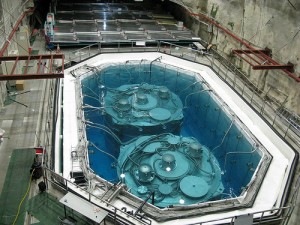
After just three months of operation, the Daya Bay Reactor Neutrino Experiment has far surpassed expectations, recording tens of thousands of particle interactions and paving the way to a better understanding of neutrinos and why the universe is built of matter rather than antimatter.
Antineutrino detectors designed and built by the Daya Bay collaboration with leadership from the University of Wisconsin-Madison are at the heart of the effort.
Embedded under a mountain near the China Guangdong Nuclear Power Group power plant about 55 kilometers from Hong Kong, the 110-ton detectors record neutrinos emitted by the reactors to probe the properties of matter and antimatter.
"When we look at the universe today there is very little antimatter and we don't know where it all went," says UW-Madison physics professor Karsten Heeger, one of the leading scientists in the Daya Bay experiment. "There must have been some imbalance in the very early universe that led to what we see today."
The completed experiment will have eight detectors in three different underground experimental halls at distances up to a mile from the reactors. The Daya Bay collaboration just released results from the first two detectors, installed last August in the hall closest to the reactors.
The preliminary results, published today on the physics preprint server arxiv.org (http://arxiv.org/abs/1202.6181), show that the detectors are already exceeding performance goals.
"This is now the largest data set of reactor antineutrino interactions ever collected," Heeger says. "This is making us very confident going forward that we can reach our science goal."
Even more importantly, the detailed analysis published today confirms that the paired detectors in this first experimental hall are recording nearly identical data. Making the detectors as identical as possible is critical to ensure that any observed differences in the full experiment are due to the physics of neutrinos, not variation among the instruments.
It's a gratifying step for the large group of UW-Madison physicists and engineers who have been involved in designing and building the detectors since 2006. The UW-Madison Physical Sciences Laboratory and Department of Physics have overseen the detectors' design, assembly and installation under the guidance of Heeger and the U.S. chief project engineer, Jeff Cherwinka from the Physical Sciences Laboratory.
"The detectors are performing very well," Heeger says. "Seeing this all come together and produce high-quality science data is very rewarding."
As the last detectors prepare to come online, Heeger's group is transitioning from a focus on the hardware and experiment construction to gathering and analyzing data. The Daya Bay experiment will study how neutrinos produced by the nuclear reactors oscillate among three varieties or "flavors" - electron, muon and tau - as they travel through space. Two of the oscillations have been studied but one transformation of electron neutrinos (called θ13 or theta one-three) has not been measured yet.
The group will compare neutrinos measured in the experimental halls near the reactors with data collected in the far halls to identify the effects of neutrino oscillation.
Story by Karsten Heeger
